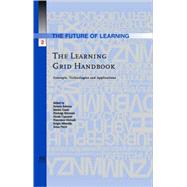The Learning Grid Handbook: Concepts, Technologies and Applications
, by Salerno, Saverio; Gaeta, Matteo; Ritrovato, Pierluigi; Capuano, Nicola; Orciuoli, Francesco- ISBN: 9781586038298 | 158603829X
- Cover: Hardcover
- Copyright: 5/15/2008
Grid technologies are rising with the next generation of Internet by defining a powerful computing paradigm. Grid could be used as a technology 'glue' providing users with a uniform way to access resources by means of several devices. These technologies can provide a support for Technology Enhanced Learning (TEL) by enabling new learning environments based on collaboration, real direct experience, personalization, ubiquity, accessibility and contextualization. Nevertheless, to be effectively used in TEL, Grid must be complemented with other elements like semantics and educational modeling; leading to the concept of 'Learning Grid' as defined in the homonymous Special Interest Group (SIG) of the European Network of Excellence 'Kaleidoscope: Shaping the Scientific Evolution of Technology Enhanced Learning'. The key challenge that Kaleidoscope is facing is the scientific and structural integration of the European TEL research. In this context, the Learning Grid SIG aims at contributing to the achievement of an improvement in TEL practices through the definition of open, distributed and pervasive environments for effective human learning taking into account that effective learning requires an active attitude of learners and that learning is a social and collaborative activity so requiring a technology that allows for active and realistic experiments, personalization, knowledge creation and evolution, as well as autonomous and dynamic creation of communities. The first section of the book is about the concept of Learning Grid and related technologies. The second chapter analyses and compares existing languages for the dynamic composition of distributed learning resources and services in aLearning Grid.







